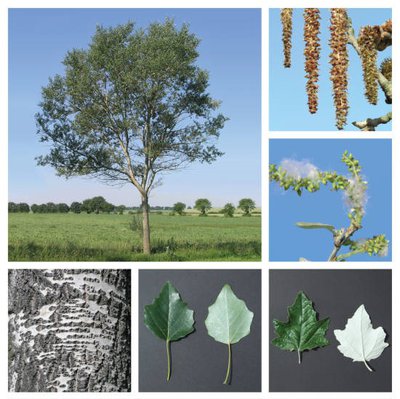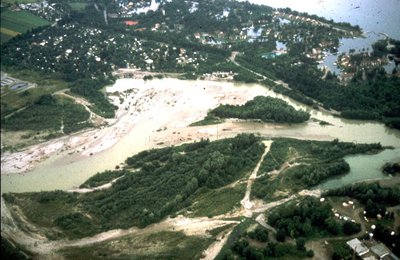The Dranse Delta: history along the water's edge

Thonon-les-Bains
The Dranse Delta: history along the water's edge
Very easy
0h45
2,6km
+13m
-13m
Embed this item to access it offline
Situated on the banks of Lake Geneva, along the Dranse River, this nature reserve is a haven of biodiversity in the heart of the urban area of Publier and Thonon-les-bains. The smallest reserve in the département, it is also the richest, with 880 plant species spread over 53 hectares. This tremendous biodiversity is the fruit of the wide variety of environments created and maintained by the delta's flow.
Attachment
- Downloadpdf
delta-de-la-dranse-une-histoire-au-fil-de-leau
Credit: Points d'intérêts du parcours - Asters-CEN74
8 points of interest

 Fauna
FaunaGarden plants gone wild!
A major avenue for seed dispersal, the Dranse river is now filled with exotic plants that have escaped from gardens and been carried down by the river. Summer Lilac (1) often confused with Common Lilac (2), Canadian Goldenrod, Himalayan Balsam, Black Locust, or even Japanese Knotweed colonize the banks of the Dranse river! For example, Japanese knotweed has shown no hesitation in spreading rapidly in patches, and even invading very large areas. These are invasive plants, competing with local flora and harming the fauna diversity! Humans are the main cause of such invasions. Asters CEN74, administrator of the nature reserve, and SIAC, in charge of river works, are implementing various measures to limit the spread of some of these plants.
 Fauna
FaunaIn the sweet company of tits
Acrobatic and hyperactive, tits never stop searching for insects in summer and for seeds in winter. Every day, they need to eat roughly their weight in food! There are many species in the tit family, 5 of which are present in the Dranse Delta nature reserve: the great tit, the blue tit, the long-tailed tit, the coal tit and the marsh tit.
M.De Groot  Flora
Flora
R.Dolques  Fauna
FaunaTo each bird its own season!
The nature reserve, a true haven for many migrating birds. Mallards, Eurasian Coots and Tufted Ducks can be seen all year round and are joined by other species depending on the season. In winter, the pond welcomes Northern Pintails, Green-winged Teals, Little Brebes and Great Cormorants. In spring new visitors arrive such as Night Herons, and more specifically the Black Kite. The population of this raptor at the the lake of Geneva is the largest in Europe! During the summer, the pond of Saint-Disdille is the only nesting location for the Black-headed Gull in the area around the lake of Geneva (including Switzerland).
 Flora
FloraAlluvial forest, a wildlife corridor
Ecological corridors provide connections between natural or agricultural environments, providing favourable conditions for wildlife to move around and complete their life cycles. Hedgerows, grassed strips and forests along watercourses are essential for maintaining biodiversity. The alluvial forest or ripisylve (ripi = bank; sylve = forest) is situated along the banks of the River Dranse. It grows on the alluvium deposits left here and there by the river as it floods. It is in direct contact with the river and the alluvial groundwater (different from the regular groundwater), which is present at shallow depths. Disturbances (flooding, erosion, fluctuations in the groundwater) play an essential role in the spread of plant species. Closer to the river, willows, alders, birches and black poplars cannot always grow as they please!
 Flora
FloraWhat wood are our crates made of?
Wild black poplar is the dominant species in riverside forests. It boasts many ecological benefits in such environments, but is under threat from river development and potential hybridisation with cultivated poplars. INRAE and ONF coordinate the national programme to conserve the species' gene pools, with the Dranse being one of the programme's key sites. A pioneer specimen that requires a lot of water and light, the poplar is fast-growing and has a long lifespan (up to 200 years). Its habitat is the riparian zone (alluvial forest) and is closely linked to the dynamics of water currents. Did you know that some cheese/fruit packagings as well as wooden crates are made with cultivated poplars?
 Lake
Lake
L.Théophile  Fauna
FaunaThe Eurasian beaver: a protected species
Two or three families, totalling eight to fifteen specimens, have settled in the nature reserve. The beaver is known to leave several indicators of its presence: bevelled branches, burrows, etc. It prefers to come out at dusk, surveying its territory on each side of the watercourse. Water is essential for this species to protect the entrance to its burrow, escape danger and carry the branches it needs to feed itself. Europe's largest rodent, the beaver is perfectly equipped for swimming: it can remain underwater for up to 15 minutes at a time without taking a breath. Its translucent eyelids protect its eyes like diving goggles. Lastly, its webbed hind paws and flat tail act as a thruster and a rudder respectively.
Description
Follow the main path from the reserve information board. Walk along the campsite on your right and Port Ripaille on your left. At the first junction, turn right to reach the bird observatory. Retrace your steps and continue straight ahead, passing the car park path on your left. Stay on the main path, ignoring the tracks at the sides. Reach the mouth of the Dranse. Turn left onto a path that winds through the vegetation, skirting Lake Geneva until you reach a small pebble beach. Take the same path back to the car park at Saint-Disdille.
- Departure : Parking "Réserve naturelle du Delta de la Dranse"
- Arrival : Parking "Réserve naturelle du Delta de la Dranse"
- Towns crossed : Thonon-les-Bains and Publier
Altimetric profile
Sensitive areas
Along your trek, you will go through sensitive areas related to the presence of a specific species or environment. In these areas, an appropriate behaviour allows to contribute to their preservation. For detailed information, specific forms are accessible for each area.
- Impacted practices:
- Aerial, Aquatic, , Land
- Sensitivity periods:
- JanFebMarAprMayJunJulAugSepOctNovDec
- Contact:
- Asters - Conservatoire d'espaces naturels de Haute Savoie
Christelle BAKHACHE : 06 49 99 99 48
christelle.bakhache@cen-haute-savoie.org
Recommandations
- The Dranse Delta nature reserve is a protected area with restricted access. Dogs are not permitted. Please follow the instructions on the information boards. - Swimming is prohibited in the Dranse
Access and parking
At Vongy (N5), follow signs for Saint-Disdille campsite, Parc de la Châtaigneraie. When you reach the Saint-Disdille roundabout, turn right towards Port Ripaille. The entrance to the car park is just after on the right, behind the "Le Must" club.
Parking :
Parking "Réserve naturelle du Deltra de la Dranse". Authorised for vehicles under 1m90cm. (6.22ft) Open from 8 a.m. to 10 p.m
Report a problem or an error
If you have found an error on this page or if you have noticed any problems during your hike, please report them to us here:

